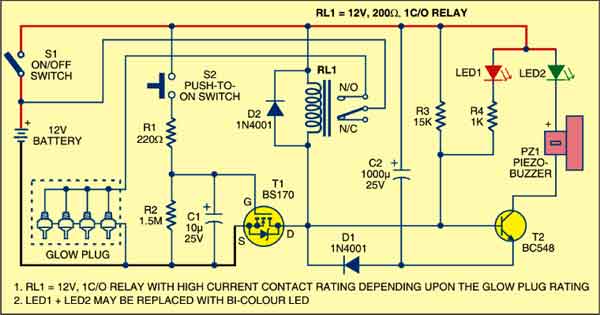 In diesel engines, the air in the cylinders is not hot enough to ignite the fuel under cold conditions. Therefore each cylinder of these engines is fitted with an electric heater known as ‘glow plug.’ A control circuit is necessary to optimise the functioning of glow plugs. It raises the air temperature inside the engine cylinder for quick and reliable starting, extended battery life and reduced diesel consumption.
In diesel engines, the air in the cylinders is not hot enough to ignite the fuel under cold conditions. Therefore each cylinder of these engines is fitted with an electric heater known as ‘glow plug.’ A control circuit is necessary to optimise the functioning of glow plugs. It raises the air temperature inside the engine cylinder for quick and reliable starting, extended battery life and reduced diesel consumption.
The glow plug controller (Fig. 1) uses a simple timer circuit built around MOSFET T1 for reliability and simplicity. Momentary pushing of switch S2 charges capacitor C1 rapidly via resistor R1. When the voltage on capacitor C1 exceeds the threshold voltage of the gate (G) of MOSFET T1, it starts charging reservoir capacitor C2 and simultaneously energises relay RL1. MOSFET T1 remains conducting as long as the voltage on C1 is greater than the threshold voltage of the MOSFET gate.

The ‘on’ time period depends on the value of capacitor C1 and resistor R2, which govern the discharge current of capacitor C2. The component values given here will produce ‘on’ time of around 25 seconds. In effect, when you press switch S2 momentarily, the relay energises for about 25 seconds and the glow plug gets the power supply through its contact.
The red LED (LED1) indicates that the heating process of glow plugs is ‘on.’ When the ‘on’ time is over, the green LED (LED2) turns on for a while, followed by a short beep from the buzzer, which indicates that the engine is ready for starting. Glow plugs draw a heavy current, hence high-current-rating contacts of an automotive relay are required.
Assemble the circuit on any general-purpose PCB and house in a suitable case. Connect the glow plug wire to the relay contact. 12V battery already available with the vehicle is used to power the circuit. Connect the piezobuzzer and LED1 and LED2 through an external connection and place it at a convenient location for the driver to operate.







